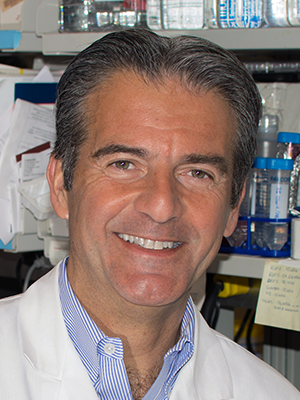Message from Constantine A. Stratakis, MD, D(med)Sci

- Constantine Stratakis, MD, D(med)Sci, Scientific Director
- Brenda R. Hanning, Deputy Director, Liaison & Training
- Carol Carnahan, Staff Assistant to the Scientific Director
- Sara K. King, Scientific Program Analyst – Board of Scientific Counselors
The 2015 annual report of the Division of Intramural Research (DIR) for the Eunice Kennedy Shriver National Institute of Child Health and Human Development is now accessible electronically, in two ways, on the web and on your cell phones or tablets, at: annualreport.nichd.nih.gov
You are invited to search the report site, whether to review our medical and scientific discoveries of the past year, to see what work a colleague may currently be engaged in, or to identify a laboratory where you may wish to collaborate or refer a student. For potential postdoctoral fellows, graduate students, and clinical fellows, the report is fully searchable. It offers you an introduction to a panoply of research endeavors in NICHD’s DIR.
NICHD intramural investigators represent a broad array of basic, translational, and clinical researchers. Our work is reflected in a new mission statement:
To plan and conduct the Institute’s laboratory and clinical research programs to seek fundamental knowledge about the nature and behavior of living systems through basic, clinical, and population-based research and determine how to apply such knowledge to illuminate developmental origins of health and disease and help ensure that women and men have good reproductive health, that children are born healthy, and that people develop to live healthy and productive lives.
We use a range of model systems in the areas of developmental biology, molecular and cellular biology, neurosciences, structural biology, imaging, behavior, and biophysics. Investigators take advantage of our resources in a 19,000-tank zebrafish core facility, working with a number of other animal models, from fruit flies to rats and mice, and supported by a wide array of core services, such as imaging, proteomics and molecular genomics. Each investigator participates in at least one, and typically more, affinity groups. The affinity groups are intended to be team-based and future-oriented—to build on thematic interests while responding to rapidly shifting scientific priorities as new knowledge is uncovered. We are looking closely at how work at the bench may translate to the bedside, through our translational research affinity group.
In particular, I invite you to read through the selection of our Clinical Research Protocols listed in this flyer and to consider how we may collaborate, through the NIH U01 grant mechanism at the NIH Clinical Center. The support of this program can lead to our next new success in therapeutics, the next miracle drug, if we combine expertise, take advantage of our NIH infrastructure and our patient population, whether on rare disorders or the most persistent problems affecting human health. clinicalcenter.nih.gov/translational-research-resources/U01/
The DIR researchers whose names appear in this publication are dedicated mentors and accomplished investigators. Link to their reports on the web to learn about their work in 2015. I also invite you to reach out to me with your ideas and proposals for collaborative initiatives we may undertake together. At our core, the scientists of the DIR seek to uncover fundamental answers to our existence, the basic science that underpins life. We seek out the connections to human health and to disease, whether very rare disorders or perturbing and persistent health challenges, on behalf of the American public and the global community.
Sincerely yours,
Constantine A. Stratakis, MD, DMSci
NICHD, NIH


